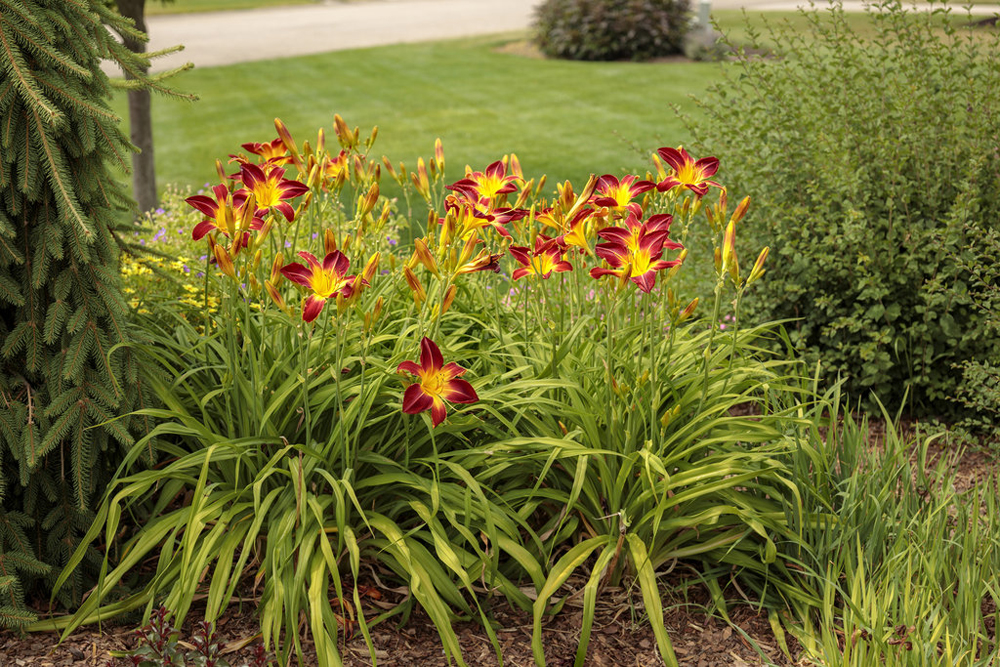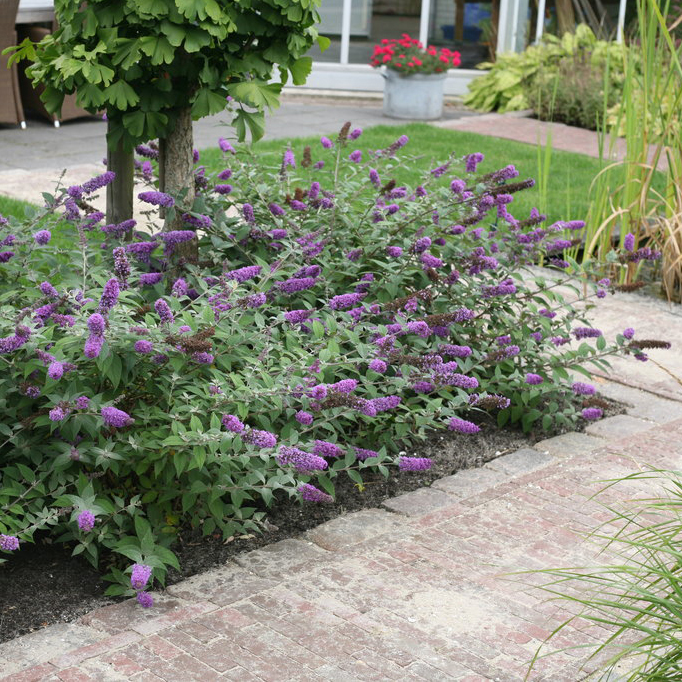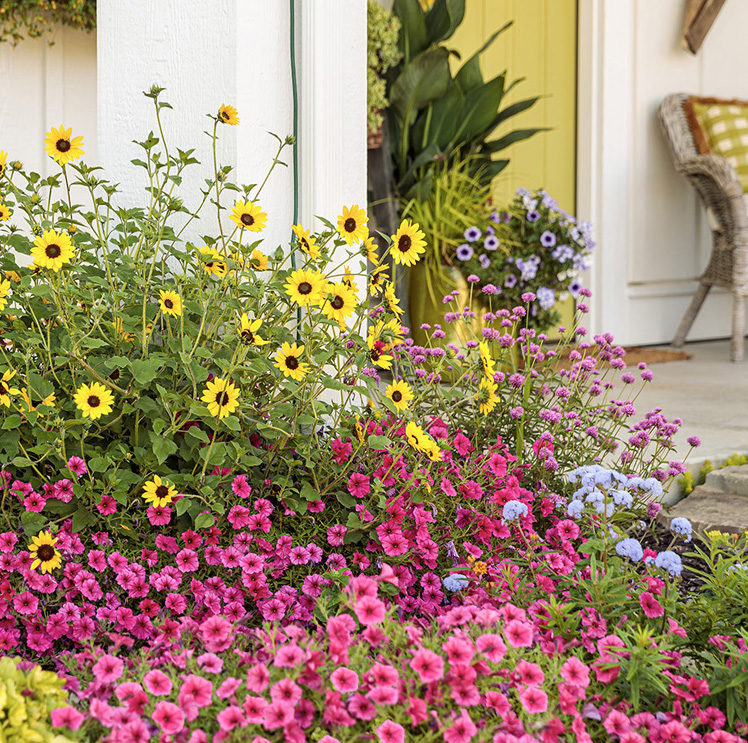10 Companion Plants for Spring Bulbs
Wondering what to pair with your spring flowering bulbs that will make a spectacular show, or which perennials will hide the bulb foliage as they go dormant? You’ll find ten answers here!
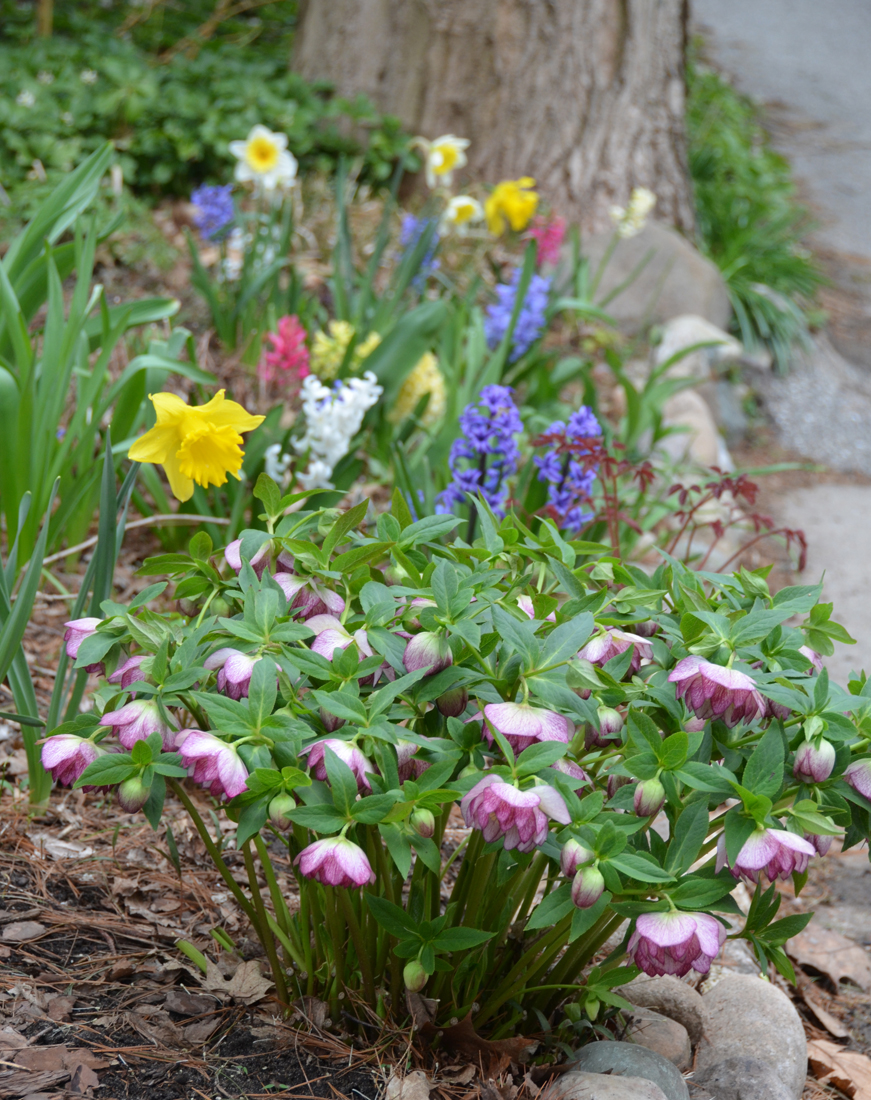
Pictured: Double pink flowered Lenten roses (Helleborus) like Wedding Party® 'Maid of Honor' are one of the first perennials to bloom in early spring, along with spring bulbs.
A beautifully balanced garden has plants in bloom from the earliest days of spring until the last days of fall. By using a mix of bulbs, perennials, annuals, shrubs and flowering trees, you will have something new to look forward to every week.
Some people shy away from planting spring flowering bulbs because they aren’t sure where to plant them or don’t like the way they look when they start to go dormant for the season. This article will give you tips to solve both of those issues, so when it is time to plant bulbs this fall, you’ll know just how to use them in your garden.
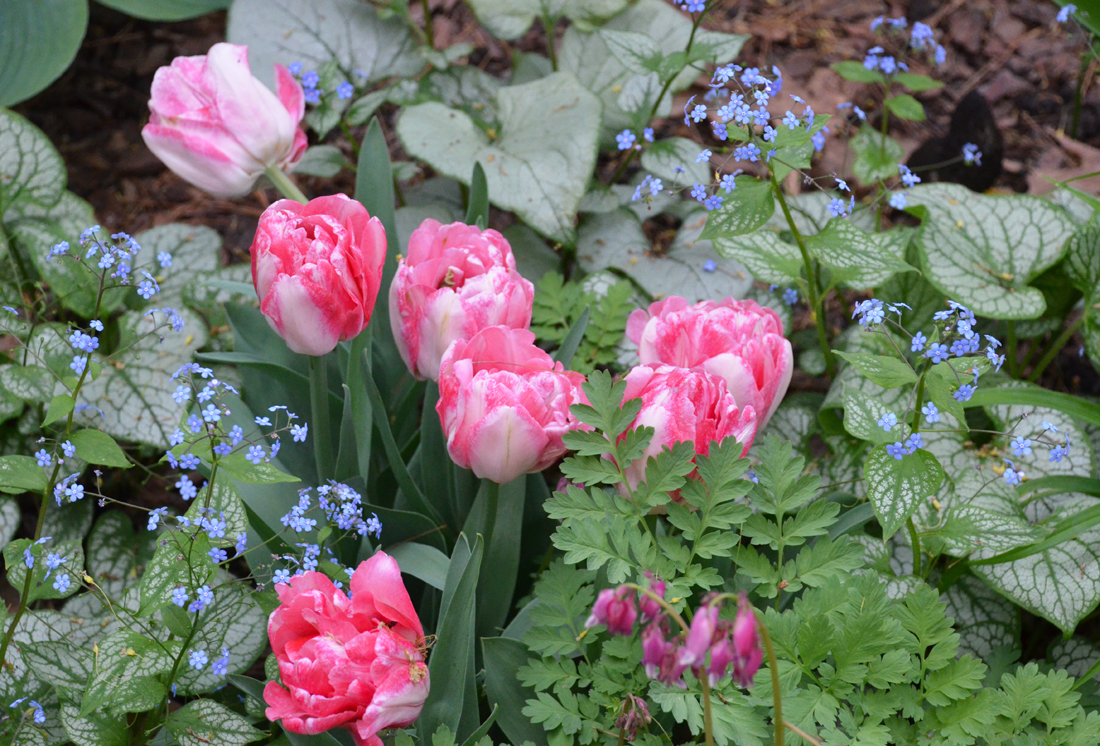
SPRING BLOOMING COMPANIONS FOR BULBS
If you plant a bag of spring bulbs all by themselves without other vegetation surrounding them, they are bound to look a little lonely come springtime. Bulbs, perennials and shrubs should work together to complement one another with their colorful flowers and foliage.
In this photo, you can see how a group of tulips was tucked in between perennial brunnera plants and bleeding hearts. The pink and white tulips blend beautifully with the silvery foliage and baby blue blossoms of their companions. Plus, once the tulips are spent and begin to go dormant, the surrounding plants will hide the browning bulb leaves.
When choosing spring blooming companions for bulbs, look for plants that will flower in the same general timeframe. Also consider the heights of both plants in bloom so they won’t cover one other up. Space them far enough apart so that they won’t become overcrowded but close enough that they are considered a pairing. Choose perennial companions that don’t require frequent division to avoid disturbing the bulbs if they are the kind that return year after year.
Five hardy, spring blooming plants that pair nicely with bulbs include:
Early flowering shrubs like azaleas and rhododendrons paired with spring bulbs creates a lively show of color to start the new season off with a bang. Their vivid pink, red, purple or white blossoms complement any bulb colors, especially sunny yellows and deep purples. When you grow reblooming varieties like Perfecto Mundo®, you’ll have flowers in spring, summer and fall. If you live in the North, hardier spring blooming azaleas and rhododendrons will work great as bulb companions, too. Height: 2-3’, spread: 3-5’ (depending on cultivar), full sun to part shade, zone 6b-9 |
If you’re after a sensational spring show for your garden, plant a blanket of glowing color around your bulbs. Creeping phlox and its hybrid relatives form very short, thick cushions of finely textured foliage that become completely engulfed in vivid pink, purple or lilac purple flowers beginning in mid-spring when spring bulbs are at their peak. Daffodils, hyacinths, muscari, fritillaria and early tulips all make good companions for spring phlox. Height: 4-8”, spread: 18-24”, full sun, zone 3 or 4-8 (depending on type) |
One of the first perennials to welcome bumblebees back into the garden is lungwort. Within a week or so of emerging out of the ground, you’ll spot its flower buds forming in clusters at the tips of each stem. Most varieties bear pink buds and blue or purple flowers, with both present on the plant at once, to complement the low mounded, silver speckled foliage. Lungwort pairs perfectly with fragrant hyacinths and muscari since they are similar in height when in bloom. Height: 12-16”, spread: 18-24”, part shade to full shade, zone 3-9 |
Brunnera is the perfect companion for spring bulbs like tulips because it offers the dual benefit of blooming around the same time and having large leaves that mask the bulbs’ foliage as they are going dormant. Though it is a shade perennial and tulips prefer sun, both grow well together under the canopy of tall, deciduous trees like oaks. The bulbs receive plenty of sunshine before the trees leaf out and the Brunnera is shaded once the trees are fully cloaked in foliage. ‘Jack of Diamonds’ Brunnera has extra-large leaves that easily cover the spent tulips’ foliage. Height: 12-18”, spread: 15-32” (depending on cultivar), part shade to full shade, zone 3-8 |
This native perennial comes into bloom in late spring along with late flowering tulips, Spanish bluebells, Dutch iris and alliums. Since it grows taller than most spring bulbs, its finely textured foliage makes a pretty backdrop for shorter, brightly colored spring flowers planted in front of it. Perched atop each feathery stem is a cluster of star-shaped, light blue flowers for which the plant is named. Every four to five years, you may want to dig and divide your Amsonia. If you do so in the fall, you can plant new bulbs at its feet at the same time. Height: 18-30”, spread: 32-42” (depending on cultivar), full sun to part sun, zone 4-9 |
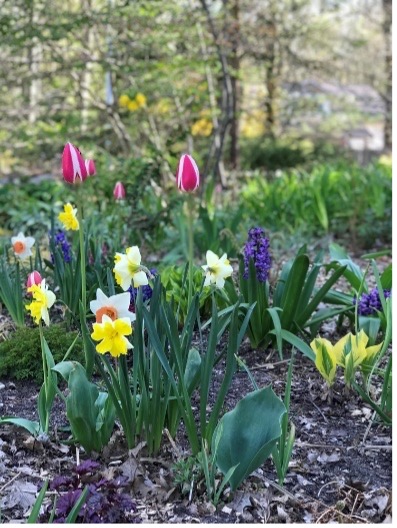
PLANTS THAT WILL HIDE SPRING BULB FOLIAGE
If you have planted quite a few spring flowering bulbs and really want them to take center stage in the spring landscape, pair them with later blooming plants instead. That way, you’ll get to extend your season of color in the garden much longer.
Choose plants that have broad foliage, a dense habit, or leaves that are similar in shape to your bulbs (for instance, daylilies or iris which have similar leaves as daffodils) to pair with your spring bulbs. That way, once your bulbs start to go dormant for the summer, their companions will cover up any browning bulb foliage. Look for perennials and shrubs that tend to leaf out later in spring so they don’t compete for sunlight or space with your bulbs.
Look closely at the picture above to see the perennials popping up at the feet of the spring blooming daffodils, hyacinths and tulips. Coral bells, bee balm, hostas, goatsbeard and daylilies will fill in this bed once the bulbs are past their prime. They will help to mask the bulb foliage.
Another advantage of planting companions with spring bulbs is that they will help to keep the soil around the bulbs drier in the summer. Once bulbs go back to sleep, they like to be kept on the dry side to prevent rotting. Companion plants will help to soak up moisture in the soil around the bulbs and, if they have large leaves, they can act like umbrellas.
Here are five plants that won’t bloom at the same time as your bulbs but will make good companions for the rest of the season.
Shortly after the bulb show comes to an end, catmint begins the next act with its periwinkle blue flowers in early summer. This perennial forms a broad clump that emanates from a central crown, and its long stems won’t prevent spring bulbs from popping up around it. However, those stems will nicely cover up the bulb foliage as it is going dormant. Bulbs with finely textured foliage like miniature daffodils, Dutch iris, muscari and crocus all make good companions for catmint. The broader habit of ‘Cat’s Meow’ catmint will cover more ground than dwarf varieties like ‘Cat’s Pajamas’. Height: 12-20”, spread: 18-36” (depending on cultivar), full sun, zone 3-8 |
Daylilies usually start popping up in mid-spring, but their leaves won’t grow too tall to block the view of your spring bulbs until early summer. Since they bloom in the summertime, they bring color to that part of the garden long after the bulbs are finished. You could plant taller bulbs like globe alliums and fritillaria behind your daylilies, or short bulbs like crocus and scilla in front of them. We also like to pair daylilies with daffodils, snowdrops and Dutch iris since the strappy leaves of the bulbs tend to blend right in with the strappy leaves of the daylilies like camouflage. Height: 20-34”, spread: 18-24” (depending on cultivar), full sun to light shade, zone 3-9 |
Hostas are some of the best and easiest companions for spring blooming bulbs in partial to full shade. They come in a vast array of shapes and sizes, many with interestingly variegated foliage or broad, bright leaves. Those that are more wide spreading will mask a greater amount of bulb foliage, so if you have a lot of ground to cover look for large varieties like ‘Coast to Coast’, ‘Diamond Lake’ or ‘Empress Wu’. Larger hostas tend to emerge a bit later in the spring, which is perfect timing for pairing with spring bulbs. They won’t crowd the bulbs out when they are in bloom, but they will gladly unfurl their leaves like an umbrella over them once they are spent. Like we mentioned above, this is healthy for the bulbs because it keeps the soil around them drier and prevents them from rotting. Height and spread vary greatly by variety, part shade to full shade, zone 3-9 |
Woody plants can make good camouflage for spring bulbs that are going dormant, too. Those that leaf out late like butterfly bush, and those with arching or spreading branches work the best. Their stems are bare in early to mid-spring when bulb flowers are blooming under and amongst their branches. Then, when the shrubs’ leaves unfurl, they seal off the view of the browning bulb foliage. Short bulbs like crocus, muscari, scilla, snowdrops and windflowers (Anemone blanda) tend to pair best with these types of shrubs. |
Right around the time when your spring bulb flowers are beginning to fade, soil and air temperatures have usually risen enough to plant annuals outside. By late spring, you should be able to plant annuals in front of the bulbs that are beginning to go dormant to help hide their foliage. Taller, more robust annuals like ColorBlaze® coleus, Suncredible® sunflowers, Angelface® angelonia, Rockin’® salvias, Truffula™ Pink gomphrena and Senorita Rosalita® cleome are all good candidates for masking bulb foliage. By the time these annuals reach full size, your bulbs will be completely dormant, and you can enjoy these colorful flowers in their absence. If you want to add more bulbs in the fall, simply remove the annuals and dig bulbs into the soil in their place. |
Want to see more?
- Hosta Companion Plants
- Explore our entire collection of annuals, perennials and shrubs.
- We offer spring bulbs for fall planting! Jenny from Creekside explains in this video.
- Save pins of spring flowering plants from our Pinterest board.









